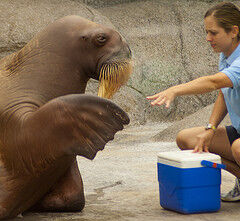From the moment they are born, animals have innate behaviours; that is, they act instinctively, without thinking. Animals, therefore, naturally have certain skills. In fact, these innate behaviours depend on the genetic makeup of the species; instincts are encoded in their genes. Because of this, all individuals of the same species should have the same innate behaviours.
There are innate behaviours that cause attraction or repulsion towards an object or another individual according to certain external stimuli, as is the case in plants with tropisms. There are also innate behaviours called reflexes, which are spontaneous reactions in response to stimuli.
Placing a dead fly near a toad will not cause the toad to react by instinct. However, if a small object, which is not a fly for example, but that moves, is placed in front of the toad, it will instinctively jump on it. It reacts to what moves right in front of it. Its instinct sends out a signal that whatever moves is good to eat. However, this toad may have learned, over time, to differentiate between what can and cannot be eaten. This is known as learned behaviour.
Other examples of innate behaviours:
-
birds building nests (in terms of the nest shape and the choice of materials used);
-
sunflowers facing the sun (phototropism);
-
cockroaches hiding in the presence of light (a phenomenon called negative phototaxis);
-
the female locust that responds to the calls of a male of the same species during the breeding season;
-
the search for fast waterways by the whitewater trout (these move by instinct to find their way);
-
the search for salt water by adult eels (they also move by instinct to find their way).
Behaviours that require learning are learned behaviours. Learned behaviours are expressed in 2 ways:
-
by the appearance of new reflexes (conditioned reflexes since they have become reflexes by repeating the action);
-
through thoughtful actions based on acquired experience; these are referred to as intelligent acts.
The more an animal's central nervous system is developed, the more it will be able to learn new things, storing them in its memory.
Learning is the set of behaviours by which an animal adapts to a new situation, in other words, behaviours to which it is not accustomed.
Animals learn in different ways.
|
Habit and habituation |
It is a learning process through repetition of a behaviour. |
|---|---|
|
Trial and error |
In this form of learning, the animal corrects its behaviour from one attempt to another. |
|
Imitation |
Gestures are learned by imitating an animal that has mastered this behaviour; it is often imitation of parents. |
|
Imprinting |
The animal is imprinted with the first animated object it sees and cannot separate itself from it. |
-
Certain chickadees in Great Britain have incorporated milk into their diet by piercing the bags of milk delivered to villagers’ doorsteps by the milkmen.
-
Some species of monkeys have learned to wash their food before eating it.
-
At birth, a duckling can mistakenly identify the first object that moves in front of it as its mother.
-
A cat learns to defecate in a litter box.
-
A dog learns to go to the door to relieve itself.
-
Birds manage to fly and sing, imitating their parents.
-
Birds learn to visit feeders during the winter.
If you are lucky enough to visit a zoological institution, it is very common for captive animals to be trained, mainly for the purpose of easily passing medical check-ups. Of course, these animals can learn other tricks to impress people. All it takes is a lot of patience, consistency, and rewards!
